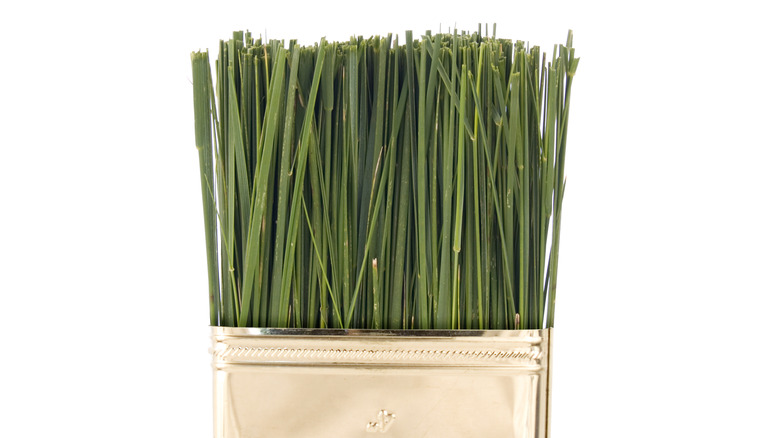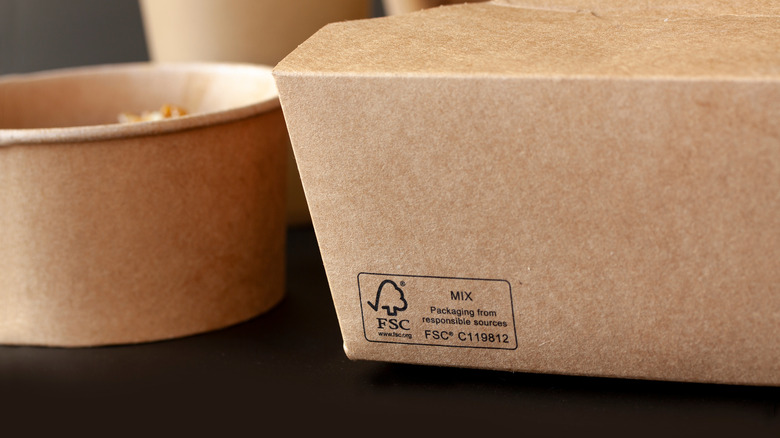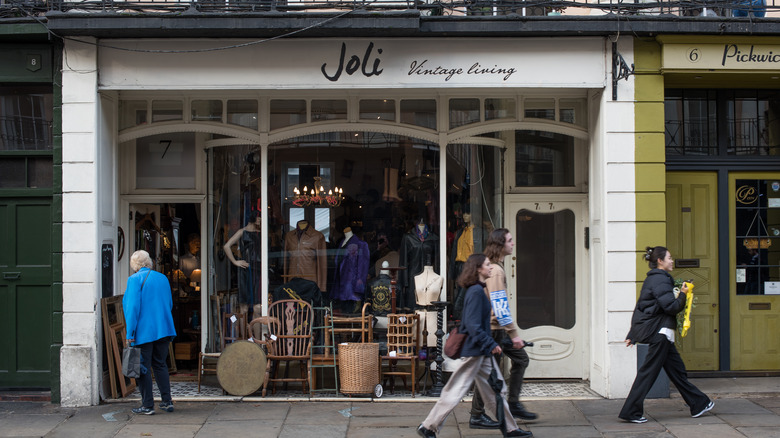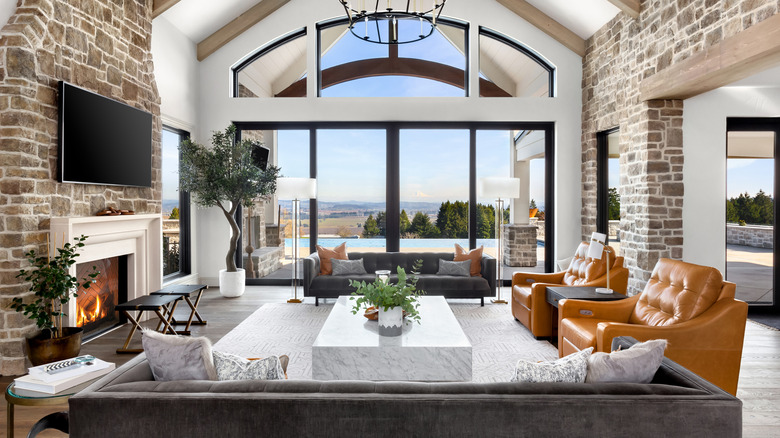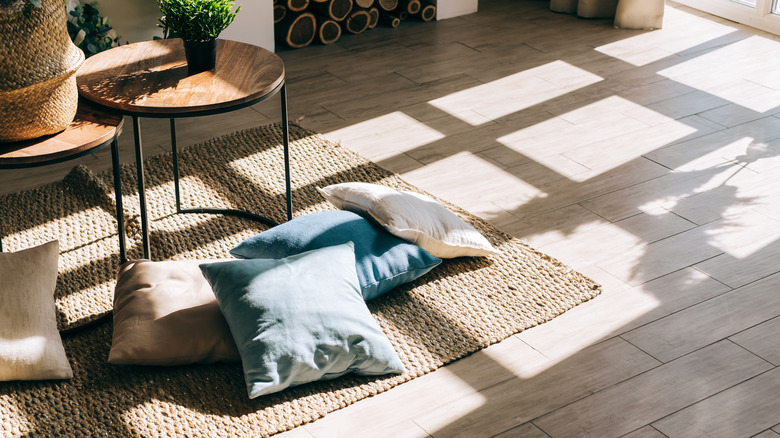How To Design Your Home With Sustainable Materials, According To An Expert
Designing your home involves many important choices. From the furniture you select to the layout itself, a home reflects many of the traits, priorities, and quirks of an individual's lifestyle and personality, notes Reader's Digest.
One important component in the design of your home comes down to sustainability and the use of responsibly sourced and utilized materials. From the use of environmentally friendly paints and flooring materials to natural fibers and furniture construction, sustainably sourced household materials can go a long way to improving your quality of life, and the environment that sustains you.
In an exclusive interview with House Digest, professional interior designer and founder of Spruce Up! — an interior design firm in London – Sarah Bowen, reveals some of the easiest and most effective ways that you can use sustainable materials and practices in your home's design. With these tips, living a more fulfilling and ecologically friendly life is practical, and can even add to the aesthetic of your home. Some homeowners may foster the idea that eco-consciousness involves the sacrifice of home luxuries and comfort, but this simply isn't the case!
Choose no-VOC paint and furniture
One of the first steps a homeowner can take is in choosing building materials that are environmentally friendly. Unfortunately, many mass-produced products contain volatile organic compounds, or VOCs. Bowen explains that "VOCs are chemicals released into the air when you use certain products, like paints, furniture, carpets, and building materials." She then warns homeowners, "exposure to high VOC levels can have adverse health effects, including irritation, headaches, and allergic reactions. Long-term exposure may also cause damage to the liver, kidney, and central nervous system." For peace of mind, when choosing new pieces of furniture, paints, or flooring, be sure to look for the low- or zero-VOC label.
Bowen also explains that our health is not the only concerning issue when it comes to VOCs. "It's believed that VOCs also contribute to air pollution and ground-level ozone formation, which can harm the environment and human health," she notes. Therefore, VOCs are also contrary to the environmentally friendly approach that you are trying to foster within your home. "No-VOC products don't contain these harmful chemicals, making them better for the environment AND your health," finishes Bowen.
Look for FSC-certified woods
Another important consideration to make when purchasing new furniture (or building your own) or installing new floors, is the use of sustainably sourced lumber. Bowen says: "If you're into a bit of DIY and plan on using wood in your home design, ensure it's FSC-certified. These products are made from trees harvested sustainably, preserving the natural ecosystem, protecting wildlife habitats, and ensuring that the forest can continue to thrive and regenerate over time." FSC-certified timber is produced in line with guidelines created by the Forest Stewardship Council and will showcase the FSC logo on each piece.
For a homeowner, it may take a little more time and effort to ensure the products they use are environmentally friendly, however, the consequences of not doing so mean that non-sustainable timber harvesting and deforestation will continue. Moreover, choosing timber from sustainable sources comes with additional benefits. "FSC-certified wood isn't only a good choice for the environment," notes Bowen, "but for your home design, too. It is often of higher quality, making it easier to use for structural elements like beams, flooring, and support posts, as well as decorative pieces like trim and molding."
Shop vintage
Vintage styles are making a comeback in the world of home design. Homeowners are enthralled by the nuanced designs that vintage pieces bring to their homes, but this isn't the only benefit. Bowen says: "Recycling old furniture pieces by shopping on Facebook Marketplace, garage sales, and thrift stores helps cut down on manufacturing. The manufacturing process (and transportation of the goods) can produce harmful emissions and waste, including air pollution, water pollution, and solid waste." Looking for older pieces can provide a greater level of durability, too. Custom Home Group notes that generally speaking, the older a piece is, the more likely it is to have been well-made and crafted with high-quality materials.
"By shopping vintage," Bowen continues, "you also reduce the use of natural materials — many manufacturing companies will use resources from unsustainable sources, like old-growth forests and environmentally sensitive areas. Furthermore, furniture that people throw away often ends up in landfills, so you save a beautiful piece of furniture by shopping vintage." The choice to incorporate vintage styles doesn't need to end with furniture either. Thrift stores and antique shops are great places to find things like light fittings, mirrors, or decor items.
Use natural materials rather than human-made
Human-made materials are often harsh on the environment. Plastics and other fabricated building options won't break down effectively in the same way that natural products do. Bowen explains that "using natural materials is an excellent way to reduce your carbon footprint if you're trying to be more eco-friendly in your home's interior design. Raw materials like wood, stone, and clay are abundant and renewable, so using them can help reduce the demand for limited resources, such as oil and minerals." She continues: "When you choose natural materials, you also reduce pollution by not funneling more money into producing synthetic products like plastics and synthetic fibers."
In addition, natural products can make for a more soothing and relaxing home that fits directly into your morals, budget, and lifestyle. Bowen goes on to say "eco-minimalism is well and truly in right now, so by choosing natural materials, you'll be bang on-trend." Many modern designs incorporate bamboo, rattan, and straw, so if you are trying to create a boho-chic or farmhouse look in your home, eco-friendly furnishings should work perfectly with your designs.
Use reusable materials
Reusable materials are another important step in the right direction when seeking to develop a sustainable home design. Bowen directs homeowners to "look for soft furnishings, including bedding, towels, curtains, and upholstery made from reusable materials such as organic and non-dyed cottons and linens." These are highly visible pieces in any home, so using sustainable materials across your soft furnishings can bring a new aesthetic to the fore.
"Linen and cotton are natural, biodegradable materials that can be a good choice for home design," she says. "Both linen and cotton are made from plant fibers and can be an incredibly sustainable choice, as these materials are grown without synthetic pesticides and fertilizers. Organic cotton is also typically grown using less water than conventionally grown cotton, which can help to conserve resources." Organic cotton and linen fabrics are incredibly soft, and their presence in your home can provide a light atmosphere that is always a pleasure to be in. Combined with the increased sustainability that they invite into your space, there will always be something to celebrate while settling down with a cup of coffee and a book, or with friends and family.

